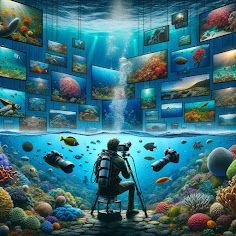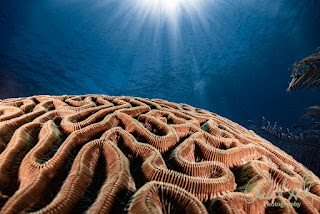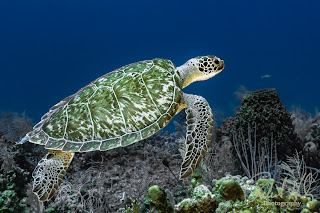Crafting Your Underwater Photography Portfolio: A Comprehensive Guide
I often get asked how I was able to land a great job as a Professional Photographer, being published in many dive magazines, and working and living in the Caribbean, on a beautiful Island, for a top resort? One of the ways I did this was through building a compelling portfolio. Below are some great tips and methods for accomplishing this for yourself.
Creating an underwater photography portfolio is an exciting endeavor that showcases your skills, creativity, and passion for the underwater world. A well-crafted portfolio not only displays your best work but also serves as a key tool in expanding your reach, connecting with clients, and securing features in magazines or online platforms.
Whether you're a seasoned diver with a camera always at the ready or a photographer venturing below the surface for the first time, building a compelling underwater photography portfolio is your ticket to showcasing your work, capturing hearts, and opening doors to new opportunities.
Here's a comprehensive guide to help you build an impactful underwater photography portfolio:
Purpose of Your Portfolio
Your portfolio is more than just a collection of images; it's a reflection of your identity as an underwater photographer. It plays several crucial roles, such as:
- Showcase Artistic Talent and Vision: Presenting your best shots in a coherent collection reflects your skills and personal style.
- Your Diversity: Exhibiting the breadth of marine environments and life forms you've successfully captured, showcasing your adaptability and keen eye for detail.
- Open Professional Doors: Serving as a bridge to connect with galleries, potential clients, agencies, and publications that might be interested in your work or perspective. Facilitating opportunities to have your photographs displayed in exhibitions, featured in renowned magazines, or spotlighted on prominent online platforms.
- Define Your Brand: It helps in carving out a niche for yourself in the vast sea of photographers, distinguishing your work from others.
Contents of the Portfolio
An exceptional underwater photography portfolio should be
rich in diversity and quality, including:
- Varied Environments: Photos from different underwater settings like vibrant coral reefs, haunting shipwrecks, mysterious caves, and the vast open ocean demonstrate your adaptability and skill in various conditions.
- Underwater Landscapes: The surreal beauty of underwater environments, from coral reefs to the haunting allure of shipwrecks.
- Macro Shots: Close-up images that reveal the intricate details and textures of marine life.
- Captivating
Marine Life: A collection of photos depicting a wide range of marine
creatures, from the tiniest macro subjects to grandiose shots of pelagic
life, showcases your ability to capture the essence of the underwater
world.
- Human
Elements: Images portraying human interaction with the aquatic
environment add a relatable and dynamic aspect to your portfolio,
illustrating the connection between humans and the ocean.
- Conservation
Themes: Photographs that tell a story or convey messages about marine
conservation can distinguish your portfolio, resonating with viewers and
emphasizing the importance of preserving our oceans.
Organizing Your Portfolio
Curating your portfolio thoughtfully is crucial for making
an impact. Here are some guidelines:
- Begin
and End with a Bang: Start with some of your strongest images to grab
attention, and close with equally powerful works to leave a lasting
impression.
- Maintain
a Flow: Group your work in a way that feels natural and tells a story,
whether it’s by theme, color, or subject matter.
- Quality
Over Quantity: A selection of 20-30 exceptional images is more
effective than a larger collection of mediocre shots.
Photo Quality and Size
- Resolution:
High-resolution images are crucial. Aim for a minimum of 300 dpi (dots per
inch) for printing purposes and at least 1920 pixels on the longest side
for digital viewing.
- File
Format: Use JPEG or TIFF for the final presentation, but ensure you
have RAW files as they offer the best quality for edits.
- Aspect
Ratio: Maintain a consistent aspect ratio (e.g., 3:2 or 4:3) unless a
creative decision dictates otherwise.
Showcasing Your Portfolio
In today’s digital age, there are multiple platforms to showcase your underwater photography portfolio:
- Digital
Presence: Establish a professional online portfolio or utilize
reputable platforms to display your work. Include an introductory page,
detailed contact information, and narratives or insights behind each
image.
- Social
Media Engagement: Leverage social media platforms to extend your
reach. Regular updates and interactions with your audience can
significantly enhance your visibility and engagement.
- Print
Portfolio: A tangible portfolio can have a profound impact,
particularly when engaging directly with gallery owners, and clients, or at
professional meetings.
Expanding Your Reach
To broaden your audience and secure features in magazines or
online platforms, consider these strategies:
- Targeted
Research: Identify and research magazines and online publications that
align with your genre of underwater photography. Familiarize yourself with
their submission requirements and editorial preferences.
- Professional Networking: Engage in photography events, exhibitions, and workshops to build connections with industry professionals, including editors, photographers, and potential clients
- Online Platforms: Websites like Behance or 500px allow photographers to share their work with a large audience and connect with other professionals.
- Direct Outreach: Craft personalized pitches for each publication, articulating your unique perspective, the essence of your portfolio, and the synergy between your work and their platform.
- Participation
in Contests: Entering photography contests can offer valuable exposure
and add credibility to your work, opening doors to new opportunities.
Networking
- Join
Photography Groups: Engage with photography groups, both online and
offline. Workshops and dive trips can also be excellent networking
opportunities.
- Contact
Professionals: Don’t hesitate to reach out to established underwater
photographers for mentorship or advice. Their guidance can be invaluable.
Final Thoughts
Building an underwater photography portfolio is a process of
continuous improvement and networking.
Stay tuned and "Follow" for upcoming blogs on underwater photography tips and tricks for more in-depth insights. Please leave your comments and suggestions. Enjoy your diving and shooting experience!
I am eagerly anticipating your valuable feedback and suggestions.
Sincerely,
Bob Herb
|
|





Comments
Post a Comment
Please let me know your comments.